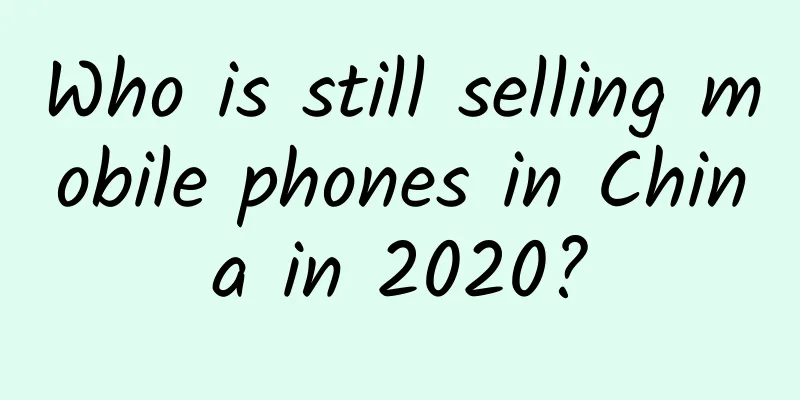Who is still selling mobile phones in China in 2020?

|
It’s so difficult to sell mobile phones in China. The smartphone market has changed too fast and too cruelly, probably beyond most people's expectations. Four years ago, Meizu could still compete with Huawei, and Hammer had the courage to compete with Apple. At that time, the market space was large enough and everything could be imagined. But in 2018, everyone has to face the reality. The slowest companies can only be eliminated or survive in the cracks. By 2019, Apple's mobile phones will soon be unsaleable in China, and can only rely on large discounts to boost performance. Samsung's last factory in China, located in Huizhou, Guangdong, has also stopped production and closed. By 2020, who will still sell mobile phones in China? It’s so hard to sell mobile phones in ChinaIn 2016, GfK, one of the world's top five market research groups, published a report saying that the growth of China's smartphone market has become a driving force for the growth of the global smartphone market. The characteristic is that the shipment volume of mobile phones in the North American market has begun to show a downward trend, while the sales volume in the Chinese market has continued to grow significantly. However, data from the China Academy of Information and Communications Technology shows that in 2018, the overall shipments of the domestic mobile phone market declined year-on-year. In 2018, the overall shipments of the domestic mobile phone market were 414 million units, a year-on-year decrease of 15.6%. From January to June 2019, the overall shipments of the domestic mobile phone market were 186 million units, a year-on-year decrease of 5.1%. Selling mobile phones in China is no longer an easy task. 1. The Chinese market has become a pioneer in the global mobile phone market China's smartphone market shipments have begun to decline, but domestic mobile phone manufacturers have also squeezed into the forefront of the world in the process of intelligence. The high investment and high degree of freedom of competition in China have torn apart this originally peaceful market. In the past, the world's largest emerging market has become saturated, but the competition has not stopped. Today, Chinese mobile phone brands Xiaomi, Huami and ov are the first to advance into 5G and constantly refresh the form of mobile phones. The Chinese market has transformed from an emerging market to a pioneer in the global mobile phone market. 2. The reshuffle of domestic players is over, and the world's top manufacturers are gradually fading out In the smartphone boom, new and old brands in the Chinese market are gearing up for the fight, but as the dividends decline, we see Gionee and Smartisan go out of business, while Lenovo and Meizu struggle on the line between life and death. The strong always get stronger, but it is not easy for Xiaomi, Huawei and OV. Mainstream global brands that did not seize the opportunity have also become niche brands in China, until they finally bid farewell to the Chinese market. In 2016, Samsung's market share in China was 4.9%, which dropped to 2.1% in 2017 and fell below 1% from the second quarter of 2018. It is a painkiller for the second and third echelons going overseasSamsung is highly globalized. Although it has lost the Chinese market, its global shipments are still the world's number one. It can be said that globalization is Samsung's strong moat. The difficulty of the Chinese market comes from two aspects: on the one hand, the smartphone market is saturated, and on the other hand, the competition among similar competitors is fierce. For second- and third-tier players, expanding overseas markets with existing strength is the best choice at present. 1. Transsion has become the king of mobile phones in Africa. Internationalization is actually the way out for the weak. On September 30, Transsion Holdings was officially listed on the Science and Technology Innovation Board. Transsion's weak technology was the biggest uncertainty for the company before its listing. As of the date of signing of the prospectus, the company's core technology has formed a total of 630 patents, and a total of 1,655 domestic and foreign patents are being applied for and accepted. In comparison, the patent reserves of Huami OV are all over 10,000. However, based on the African market, Transsion has been deeply developing mobile phones with cost-effectiveness and localization as its orientation. It has developed dual-SIM dual-standby, triple-SIM triple-standby, and even quad-SIM quad-standby mobile phones that are needed in the African market. It has also improved its photography technology to address the skin color issues of African blacks. In 2018, the company's feature phone sales accounted for 72.76%. According to previous statistics from IDC, Transsion's global market share reached 7.04%. Its market share in India reached 6.72%, ranking fourth. Its market share in Africa reached 48.71%, ranking first. 2. The node of demand for cost-effectiveness has passed, and Xiaomi has been suppressed and its domestic growth is weak. According to data released by CINNO Research, in the first half of 2019, domestic smartphone sales reached 190 million units, a year-on-year decrease of 6.0%. Among them, Xiaomi's domestic sales fell sharply by nearly 20% during the same period. On the one hand, the demand for cost-effectiveness has passed, and Xiaomi's impact on the high-end market after the split from Redmi is still strongly suppressed by Huawei. On the other hand, Xiaomi is not as good as Redmi and Greenmi in laying out domestic sales channels. Therefore, domestic growth lacks momentum, and its market share is only 12.3%, ranking fourth. In the semi-annual report released by Xiaomi in 2019, the sales volume of Xiaomi mobile phones in the second quarter was 32.1 million units, which was only 100,000 units more than the same period last year. Although the domestic sales volume declined, the overall shipment volume of Xiaomi still maintained the same period last year, mainly due to the rapid development of Xiaomi in the overseas market. We can see from the iiMedia Research "2018-2019 Chinese Smartphone Brand Southeast Asia Market Research Report" that since 2018, while the domestic smartphone market has continued to be sluggish, Xiaomi's global smartphone shipments have risen against the trend. In 2018, the growth in Xiaomi's mobile phone sales mainly came from India and Western Europe. In India, Xiaomi had only 3% of the market share in 2015, but ranked first with a market share of nearly 30% in 2018. In addition, according to Canalys statistics, Xiaomi ranked fourth in the European market in terms of shipments in Q2 2019, with a year-on-year growth of 48%, ranking first in growth rate. 3. Huawei has struggled to break into the European market, but is now facing strong external obstacles. For second- and third-tier players, globalization is a lifeline to the current sales decline, but this is not the case for top players. As international trade conflicts intensify, these top players are more affected by trade frictions. Previously, the United States did not allow Huawei to use Google Mobile Services (GMS), but even if it was not pre-installed by the official, users could still install it manually. However, according to the latest news, the plan to install the full range of Google applications on the Huawei Mate 30 series has been completely blocked. In addition, Google has removed the Huawei Mate 30 from its SafetyNet system (a list of trusted devices that can access Google services). This means that Huawei Mate 30 series mobile phones are not only hopeless to install later, but even if they have been installed before, they will now be affected, and these impacts have just begun. Competition intensifies as top players seek a new playing fieldEmerging markets still rely on price/performance ratio, and require extreme localization, which is a must-win for second- and third-tier players who have nowhere else to go. However, for top players, who already have a high penetration rate worldwide, and with the increasing uncertainty in overseas markets, this may not be a high return on investment option. 1. Globalization is not a lifeline for top players After decades of hard work, Huawei has gained a place in the overseas high-end market. Its market share in Europe once reached 26%, only 5 percentage points behind Samsung, the first place. However, judging from the data, the impact of banning Google on Huawei worldwide is actually greater than we imagined. According to the latest analysis report released by Canalys, Huawei lost some market share in Europe in the second quarter of this year, with a year-on-year decline of 16%, and a market share of 18.8%, ranking second. Ren Zhengfei also admitted in an interview that overseas shipments will drop by about 40% to 60% in the future. This impact is difficult to eliminate in a short period of time. Therefore, Huawei's actual business focus has shifted back to China, hoping to use space in the domestic market to exchange for time in the international market. Apple actually performed even worse globally. Its financial report for this quarter showed that its revenue in Greater China, the company's largest overseas market, was US$9.157 billion in the third quarter, down 4% year-on-year; its revenue in Europe was US$11.925 billion, down 2% from the same period last year. 2. Mobile phones are not a growth engine for leading players Apple's mobile phone sales continued to decline this quarter, with net sales of the iPhone business in the third fiscal quarter reaching $25.986 billion, down about 12% from $29.470 billion in the same period last year. The iPhone business is no longer an important growth engine for Apple's revenue. In terms of other hardware products, the third-quarter financial report showed that iPad tablet revenue was US$5.023 billion, up from US$4.634 billion in the same period last year, an increase of 8% year-on-year; Mac devices, including notebook and desktop computer business, had net sales of US$5.820 billion, up 11% from US$5.258 billion in the same period last year. However, the biggest highlight in Apple's financial report this quarter came from wearable devices such as Apple Watch, HomePod and AirPods. The sales revenue of wearable devices and accessories increased by nearly 50% year-on-year. And service revenue also performed relatively steadily. From the perspective of overall revenue, service revenue is more than 10 billion US dollars every quarter. 3. The new system has a long way to go, but it may be the starting point of a new arena Whether actively or passively, by breaking away from the simple mobile phone market and standing at a new level of AI, IoT or 5G, the leading players actually have the ability to redefine the playing field, and perhaps there is greater space there. On August 9 this year, Huawei's Hongmeng operating system was forced to be released. The release was hasty but also relieved most people. Because Huawei has the foresight to lay out the entire ecological service system from the perspective of the Internet of Things. Hongmeng OS uses a distributed architecture for the first time to achieve modular decoupling, supporting not only mobile phones, but also wearable devices, vehicles, speakers and other smart devices. But Rome was not built in a day. At the Munich launch of Huawei's Mate 30 series of mobile phones, Huawei also launched Huawei Mobile Services (HMS). Currently, HMS has integrated 45,000 applications, but there are still tens of thousands of applications that need to be adjusted and adapted. Perhaps influenced by the increase in Google's ban level, Huawei, which does not actively use the Hongmeng system, has accelerated its development pace. On October 4, foreign media reported that Huawei has registered a new trademark for the system in overseas markets. The new trademark will cover a variety of products including smartphones, laptops, tablets, wearable devices, smart speakers, routers, smart TVs (smart screens), cars, etc. It can be seen that second- and third-tier mobile phone manufacturers are increasing their efforts to expand overseas, while top players are looking for space in a higher dimension. In 2020, selling mobile phones is no longer important, and how many mobile phones can be sold in China is not so important. What is important is how mobile phone manufacturers can stabilize the overall situation and complete the staged transition when the market is full of obvious turning points, and meet the challenges of greater space at a new level. |
<<: Why are 5G mobile phones not selling well?
>>: Apple officially abandons iTunes! How to sync iPhone and iPad to Mac?
Recommend
My first experience with advertising embedded in the body of a public account. What is the promotion effect?
Some time ago, my official account was fortunate ...
The activities were also carried out, so why was the community still "killed" by the operation?
There are many entrepreneurial teams and companie...
How much hope does UnionPay still have under the pressure from WeChat and Alipay?
[[259905]] There are also certain opportunities i...
Mayu product operation analysis!
Menstruation is a very private and important matt...
iOS 13.5 developer beta released, unlocking with a mask will be more convenient
Apple released the iOS 13.5 developer beta versio...
Growth Hacker: Amap’s Path to User Growth!
On October 1, Liu Zhenfei, Alibaba partner and pr...
Teach you step by step how to make emoticons
Do you have such feeling? When I was chatting wit...
Spoiler: WeChat version 5.5, which is currently in beta testing, adds micro-video function
[[120512]] WeChat has started internal testing of...
The most comprehensive network operation solution analysis!
1. Competitive product analysis 1. Choose competi...
Taking stock of the 4 business models of private domain traffic!
All business marketing models are ultimately for ...
Ni Jianwei's secret to explosive sales and winning orders: there is no customer or order that cannot be handled
The author of "Sales is about getting people...
How to join the Tik Tok video partner program? What are the requirements for joining the Tik Tok video partner program?
The mid-length video partner program launched by ...
When you first enter the workplace, how should you do operations work?
The daily operation of an Internet company is the...
TikTok from 0 to 1 basic course
TikTok 0 to 1 Basic Course Resource Introduction:...
A step-by-step guide to spam filtering with Python and Scikit-Learn
[[197427]] Text mining (getting information from ...









